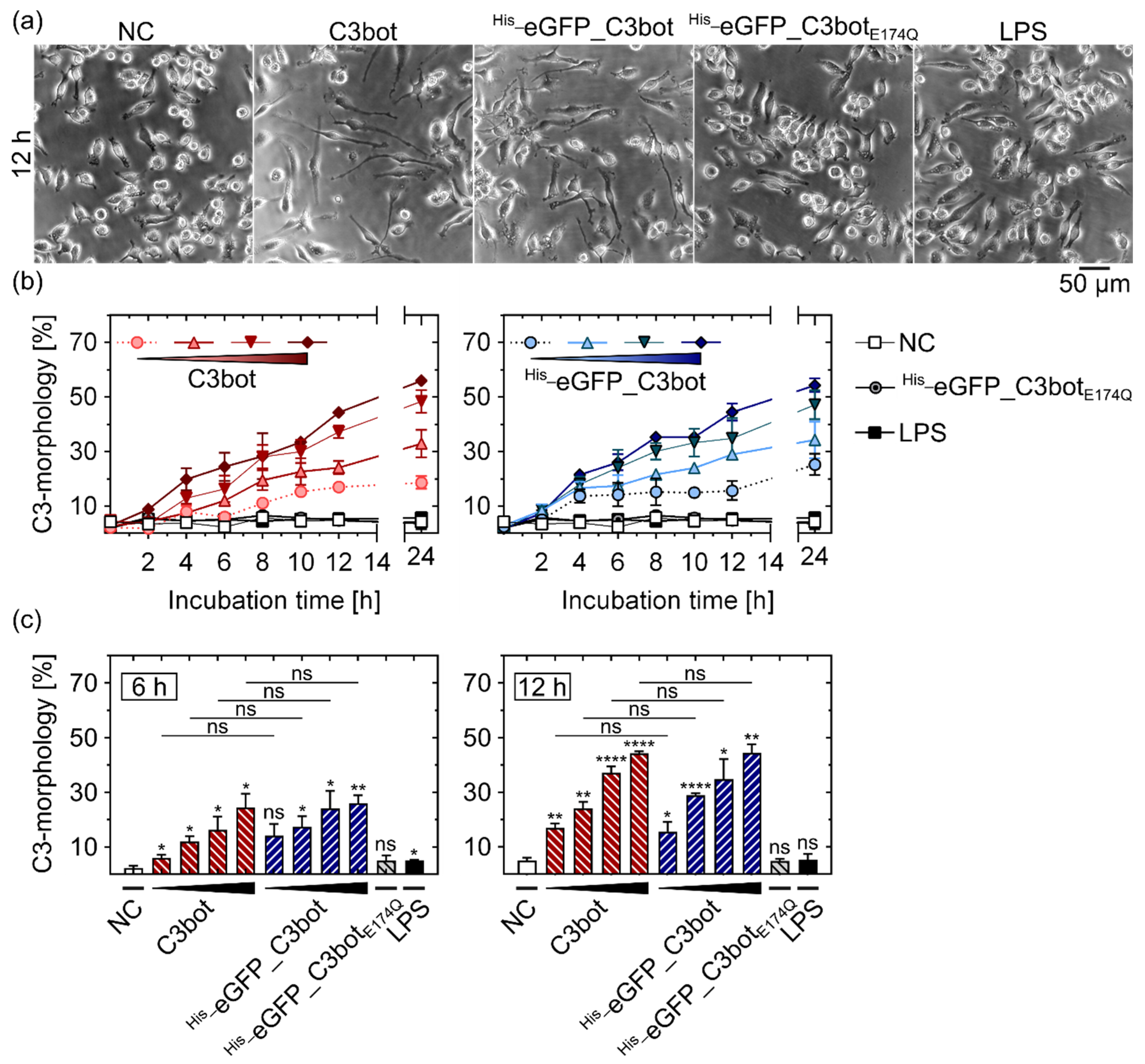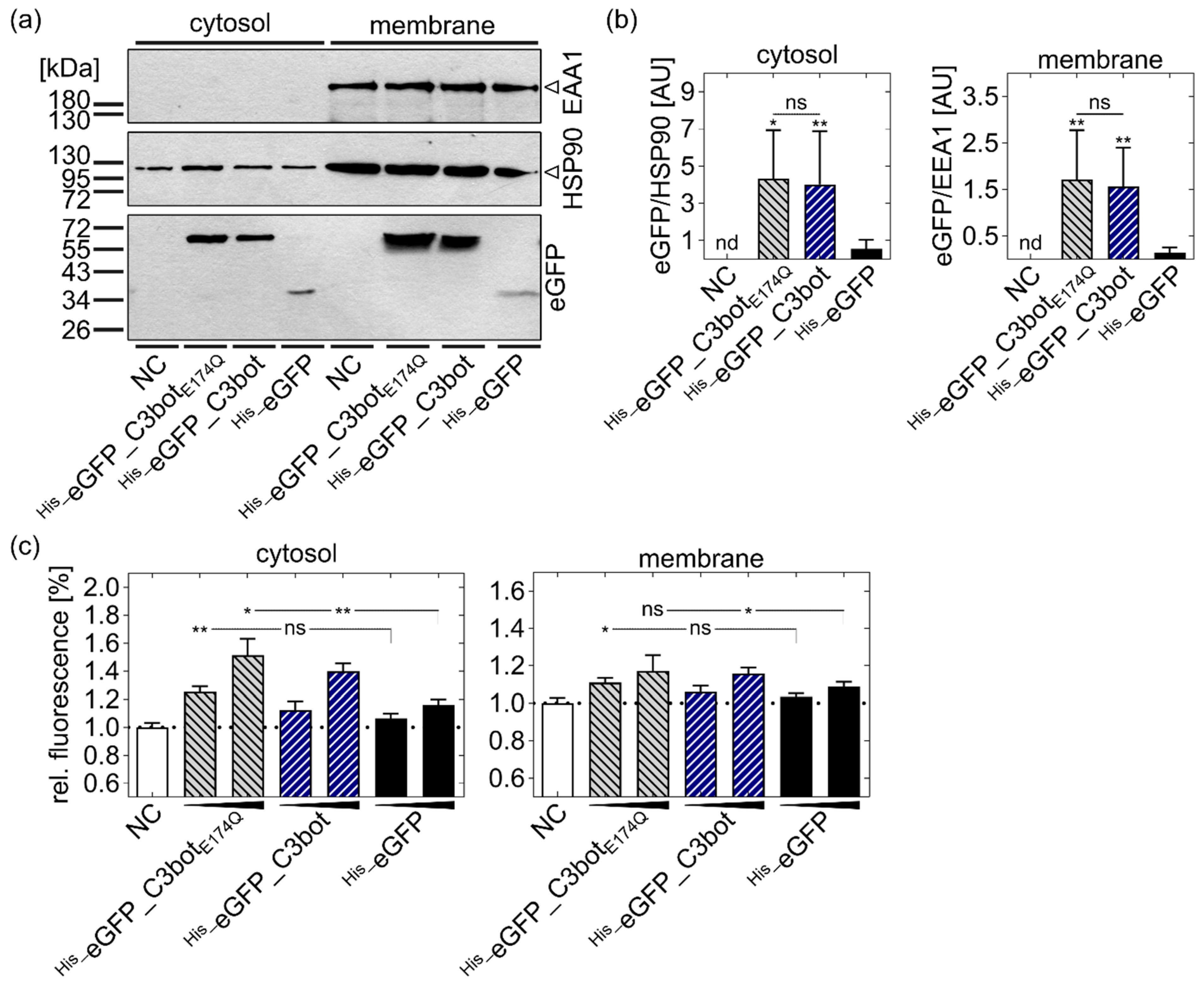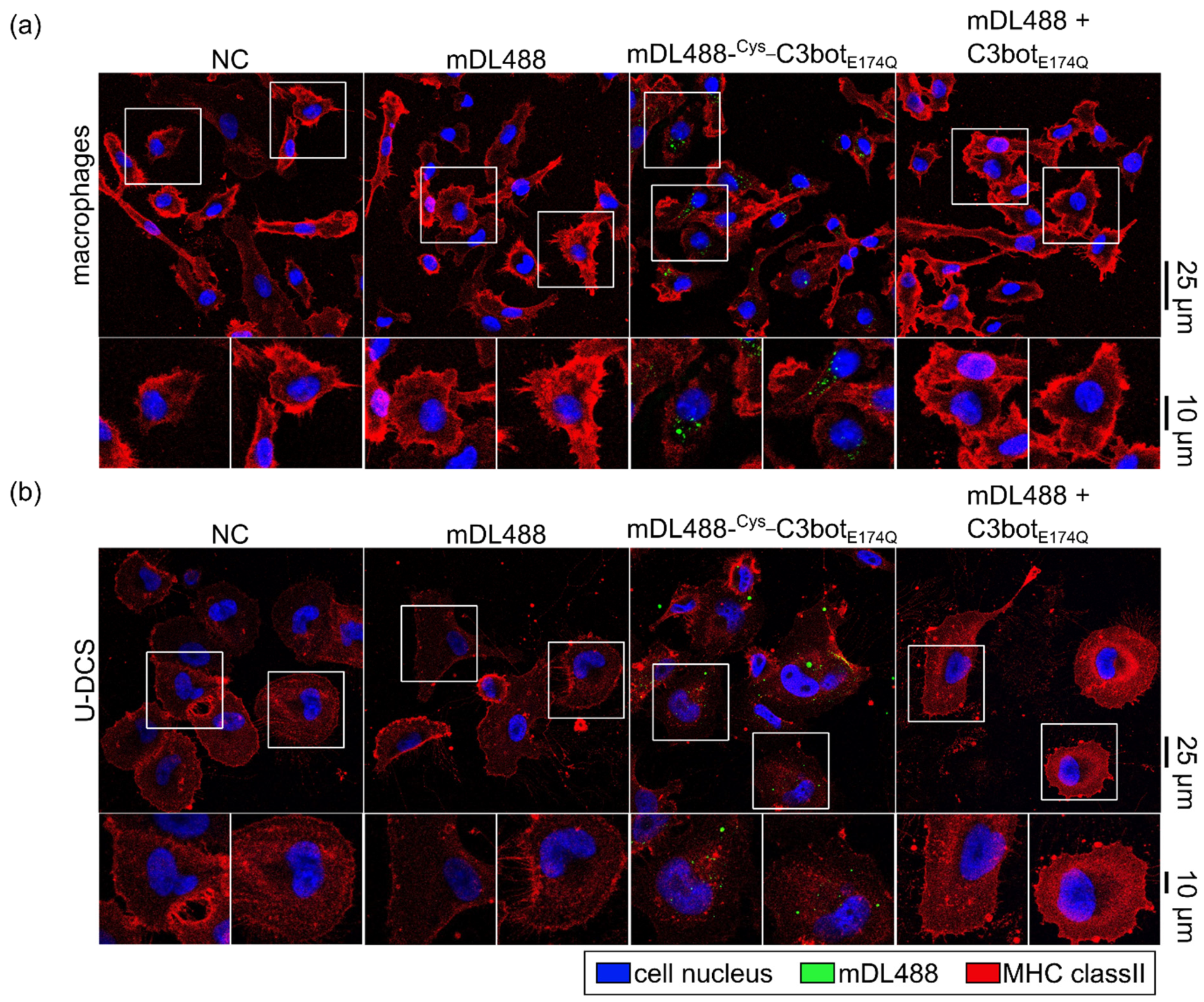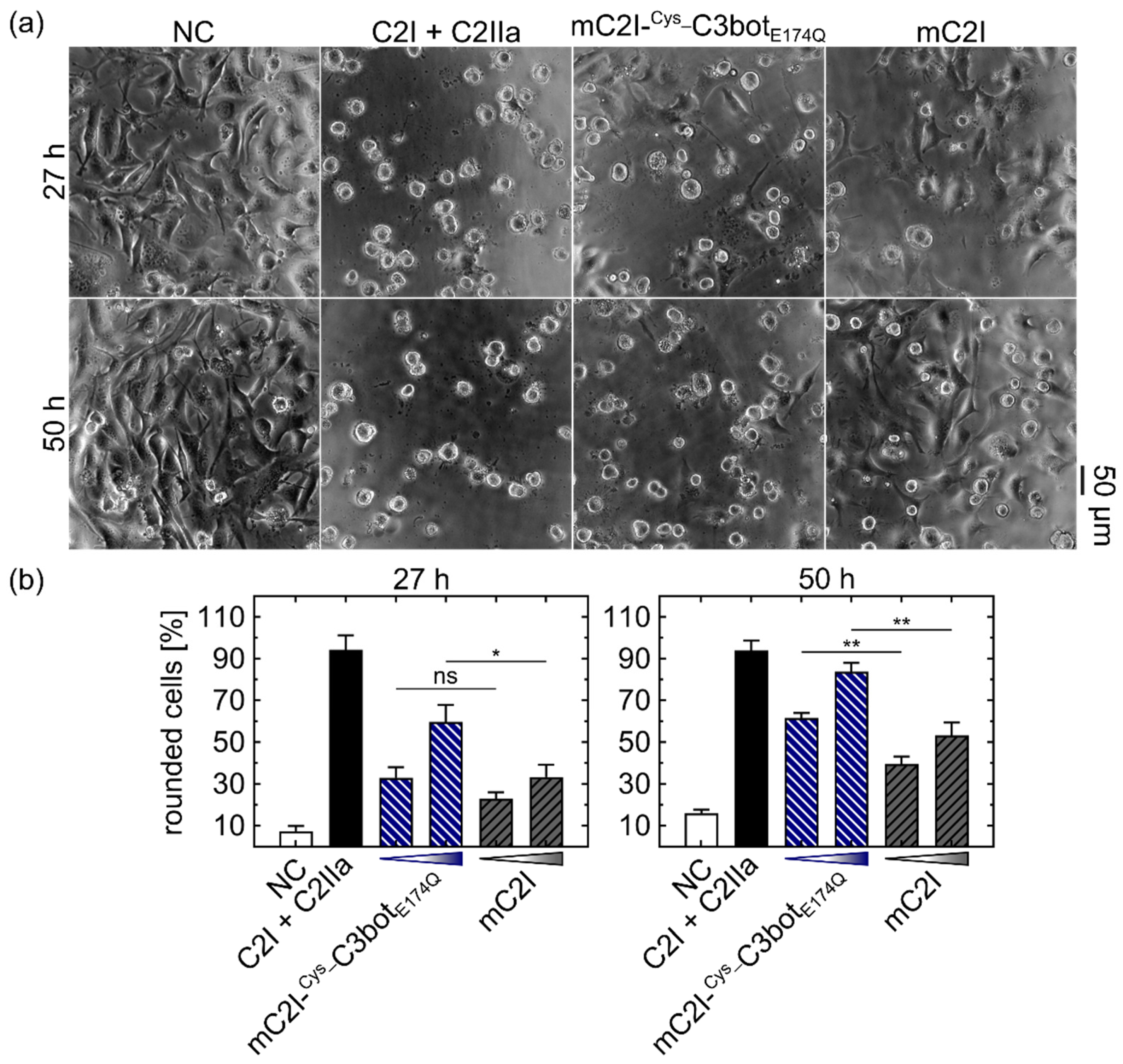Clostridium botulinum C3 Toxin for Selective Delivery of Cargo into Dendritic Cells and Macrophages
Abstract
:1. Introduction
2. Results
2.1. C3bot and C3bote174q Enhanced the Endosomal Uptake of eGFP
2.2. His_eGFP_C3botE174Q Was Selectively Internalized into Human Macrophages Ex Vivo
2.3. Functional eGFP Was Delivered into the Cytosol of DCs and Macrophages via C3bot and C3botE174Q
2.4. Characterization of a Modular System for Fast Attachment of Cargo to C3botE174Q
3. Discussion
4. Conclusions
5. Materials and Methods
5.1. Cell Culture
5.2. Differentiation of Human Monocytes into Macrophages and Co-Cultivation with Lymphocytes
5.3. Protein Expression and Cell Lysis
5.4. Purification of GST-Tagged Proteins
5.5. Purification of His-Tagged Proteins
5.6. Coupling of Maleimide-Labeled Cargo to Cys_C3botE174Q
5.7. Flow Cytometry
5.8. Phase Contrast Microscopy
5.9. Cell Viability and Proliferation Assay
5.10. STED Super-Resolution Microscopy
5.11. Immunofluorescence Staining for Confocal or Epifluorescence Microscopy
5.12. SDS-PAGE and Western Blotting
5.13. Sequential ADP-Ribosylation Assay
5.14. Digitonin-Based Cell Fractionation Assay
5.15. Data Analysis and Visualization
Supplementary Materials
Author Contributions
Funding
Institutional Review Board Statement
Informed Consent Statement
Data Availability Statement
Conflicts of Interest
References
- Popoff, M.R.; Hauser, D.; Boquet, P.; Eklund, M.W.; Gill, D.M. Characterization of the C3 Gene of Clostridium botulinum Types C and D and Its Expression in Escherichia coli. Infect. Immun. 1991, 59, 3673–3679. [Google Scholar] [CrossRef] [Green Version]
- Aktories, K.; Wilde, C.; Vogelsgesang, M. Rho-Modifying C3-like ADP-Ribosyltransferases. In Reviews of Physiology, Biochemistry and Pharmacology; Springer: Berlin, Germany, 2004; Volume 152, pp. 1–22. [Google Scholar] [CrossRef]
- Maehama, T.; Sekine, N.; Nishina, H.; Takahashi, K.; Katada, T. Characterization of Botulinum C3-Catalyzed ADP-Ribosylation of Rho Proteins and Identification of Mammalian C3-like ADP-Ribosyltransferase. Mol. Cell. Biochem. 1994, 138, 135–140. [Google Scholar] [CrossRef] [PubMed]
- Sekine, A.; Fujiwara, M.; Narumiya, S. Asparagine Residue in the Rho Gene Product Is the Modification Site for Botulinum ADP-Ribosyltransferase. J. Biol. Chem. 1989, 264, 8602–8605. [Google Scholar] [CrossRef]
- Aktories, K. Studies on the Active-Site Structure of C3-like Exoenzymes: Involvement of Glutamic Acid in Catalysis of ADP-Ribosylation. Biochimie 1995, 77, 326–332. [Google Scholar] [CrossRef]
- Saito, Y.; Nemoto, Y.; Ishizaki, T.; Watanabe, N.; Morii, N.; Narumiya, S. Identification of Glu173 as the Critical Amino Acid Residue for the ADP-Ribosyltransferase Activity of Clostridium botulinum C3 Exoenzyme. FEBS Lett. 1995, 371, 105–109. [Google Scholar] [CrossRef] [Green Version]
- Aktories, K.; Weller, U.; Chhatwal, G.S. Clostridium botulinum Type C Produces a Novel ADP-Ribosyltransferase Distinct from Botulinum C2 Toxin. FEBS Lett. 1987, 212, 109–113. [Google Scholar] [CrossRef] [Green Version]
- Nemoto, Y.; Namba, T.; Kozaki, S.; Narumiya, S. Clostridium botulinum C3 ADP-Ribosyltransferase Gene. Cloning, Sequencing, and Expression of a Functional Protein in Escherichia Coli. J. Biol. Chem. 1991, 266, 19312–19319. [Google Scholar] [CrossRef]
- Fünfhaus, A.; Poppinga, L.; Genersch, E. Identification and Characterization of Two Novel Toxins Expressed by the Lethal Honey Bee Pathogen Paenibacillus Larvae, the Causative Agent of American Foulbrood. Environ. Microbiol. 2013, 15, 2951–2965. [Google Scholar] [CrossRef]
- Krska, D.; Ravulapalli, R.; Fieldhouse, R.J.; Lugo, M.R.; Merrill, A.R. C3larvin Toxin, an ADP-Ribosyltransferase from Paenibacillus larvae. J. Biol. Chem. 2015, 290, 1639–1653. [Google Scholar] [CrossRef]
- Just, I.; Mohr, C.; Schallehn, G.; Menard, L.; Didsbury, J.R.; Vandekerckhove, J.; van Damme, J.; Aktories, K. Purification and Characterization of an ADP-Ribosyltransferase Produced by Clostridium limosum. J. Biol. Chem. 1992, 267, 10274–10280. [Google Scholar] [CrossRef]
- Just, I.; Schallehn, G.; Aktories, K. ADP-Ribosylation of Small GTP-Binding Proteins by Bacillus cereus. Biochem. Biophys. Res. Commun. 1992, 183, 931–936. [Google Scholar] [CrossRef]
- Inoue, S.; Sugai, M.; Murooka, Y.; Paik, S.Y.; Hong, Y.M.; Ohgai, H.; Suginaka, H. Molecular Cloning and Sequencing of the Epidermal Cell Differentiation Inhibitor Gene from Staphylococcus aureus. Biochem. Biophys. Res. Commun. 1991, 174, 459–464. [Google Scholar] [CrossRef]
- Wilde, C.; Chhatwal, G.S.; Schmalzing, G.; Aktories, K.; Just, I. A Novel C3-like ADP-Ribosyltransferase from Staphylococcus aureus Modifying RhoE and Rnd3. J. Biol. Chem. 2001, 276, 9537–9542. [Google Scholar] [CrossRef] [PubMed] [Green Version]
- Yamaguchi, T.; Hayashi, T.; Takami, H.; Ohnishi, M.; Murata, T.; Nakayama, K.; Asakawa, K.; Ohara, M.; Komatsuzawa, H.; Sugai, M. Complete Nucleotide Sequence of a Staphylococcus aureus Exfoliative Toxin B Plasmid and Identification of a Novel ADP-Ribosyltransferase, EDIN-C. Infect. Immun. 2001, 69, 7760–7771. [Google Scholar] [CrossRef] [Green Version]
- Ebeling, J.; Fünfhaus, A.; Genersch, E. The Buzz about ADP-Ribosylation Toxins from Paenibacillus larvae, the Causative Agent of American Foulbrood in Honey Bees. Toxins 2021, 13, 151. [Google Scholar] [CrossRef] [PubMed]
- Ebeling, J.; Knispel, H.; Fünfhaus, A.; Genersch, E. The Biological Role of the Enigmatic C3larvinAB Toxin of the Honey Bee Pathogenic Bacterium Paenibacillus larvae. Environ. Microbiol. 2019, 21, 3091–3106. [Google Scholar] [CrossRef] [PubMed]
- Fahrer, J.; Kuban, J.; Heine, K.; Rupps, G.; Kaiser, E.; Felder, E.; Benz, R.; Barth, H. Selective and Specific Internalization of Clostridial C3 ADP-Ribosyltransferases into Macrophages and Monocytes. Cell. Microbiol. 2010, 12, 233–247. [Google Scholar] [CrossRef]
- Tautzenberger, A.; Förtsch, C.; Zwerger, C.; Dmochewitz, L.; Kreja, L.; Ignatius, A.; Barth, H. C3 Rho-Inhibitor for Targeted Pharmacological Manipulation of Osteoclast-like Cells. PLoS ONE 2013, 8, e85695. [Google Scholar] [CrossRef] [Green Version]
- Rotsch, J.; Rohrbeck, A.; May, M.; Kolbe, T.; Hagemann, S.; Schelle, I.; Just, I.; Genth, H.; Huelsenbeck, S.C. Inhibition of Macrophage Migration by C. Botulinum Exoenzyme C3. Naunyn-Schmiedeberg’s Arch. Pharmacol. 2012, 385, 883–890. [Google Scholar] [CrossRef]
- Martin, T.; Möglich, A.; Felix, I.; Förtsch, C.; Rittlinger, A.; Palmer, A.; Denk, S.; Schneider, J.; Notbohm, L.; Vogel, M.; et al. Rho-Inhibiting C2IN-C3 Fusion Toxin Inhibits Chemotactic Recruitment of Human Monocytes Ex Vivo and in Mice In Vivo. Arch. Toxicol. 2018, 92, 323–336. [Google Scholar] [CrossRef] [Green Version]
- Just, I.; Rohrbeck, A.; Huelsenbeck, S.C.; Hoeltje, M. Therapeutic Effects of Clostridium botulinum C3 Exoenzyme. Naunyn-Schmiedeberg’s Arch. Pharmacol. 2011, 383, 247–252. [Google Scholar] [CrossRef] [PubMed]
- Fellermann, M.; Huchler, C.; Fechter, L.; Kolb, T.; Wondany, F.; Mayer, D.; Michaelis, J.; Stenger, S.; Mellert, K.; Möller, P.; et al. Clostridial C3 Toxins Enter and Intoxicate Human Dendritic Cells. Toxins 2020, 12, 563. [Google Scholar] [CrossRef]
- Liu, L.; Schwartz, B.R.; Lin, N.; Winn, R.K.; Harlan, J.M. Requirement for RhoA Kinase Activation in Leukocyte De-Adhesion. J. Immunol. 2002, 169, 2330–2336. [Google Scholar] [CrossRef] [PubMed] [Green Version]
- Laudanna, C.; Campbell, J.J.; Butcher, E.C. Role of Rho in Chemoattractant-Activated Leukocyte Adhesion through Integrins. Science 1996, 271, 981–983. [Google Scholar] [CrossRef] [PubMed]
- Caron, E.; Hall, A. Identification of Two Distinct Mechanisms of Phagocytosis Controlled by Different Rho GTPases. Science 1998, 282, 1717–1721. [Google Scholar] [CrossRef] [PubMed] [Green Version]
- Kippert, A.; Trajkovic, K.; Rajendran, L.; Ries, J.; Simons, M. Rho Regulates Membrane Transport in the Endocytic Pathway to Control Plasma Membrane Specialization in Oligodendroglial Cells. J. Neurosci. 2007, 27, 3560–3570. [Google Scholar] [CrossRef] [Green Version]
- Norman, J.C.; Price, L.S.; Ridley, A.J.; Koffer, A. The Small GTP-Binding Proteins, Rac and Rho, Regulate Cytoskeletal Organization and Exocytosis in Mast Cells by Parallel Pathways. Mol. Biol. Cell 1996, 7, 1429–1442. [Google Scholar] [CrossRef] [Green Version]
- Aepfelbacher, M.; Essler, M.; Huber, E.; Czech, A.; Weber, P.C. Rho Is a Negative Regulator of Human Monocyte Spreading. J. Immunol. 1996, 157, 5070–5075. [Google Scholar]
- Worthylake, R.A.; Lemoine, S.; Watson, J.M.; Burridge, K. RhoA Is Required for Monocyte Tail Retraction during Transendothelial Migration. J. Cell Biol. 2001, 154, 147–160. [Google Scholar] [CrossRef] [Green Version]
- Barth, H.; Fischer, S.; Möglich, A.; Förtsch, C. Clostridial C3 Toxins Target Monocytes/Macrophages and Modulate Their Functions. Front. Immunol. 2015, 6, 339. [Google Scholar] [CrossRef]
- Chardin, P.; Boquet, P.; Madaule, P.; Popoff, M.R.; Rubin, E.J.; Gill, D.M. The Mammalian G Protein RhoC Is ADP-Ribosylated by Clostridium botulinum Exoenzyme C3 and Affects Actin Microfilaments in Vero Cells. EMBO J. 1989, 8, 1087–1092. [Google Scholar] [CrossRef] [PubMed]
- Barth, H.; Hofmann, F.; Olenik, C.; Just, I.; Aktories, K. The N-Terminal Part of the Enzyme Component (C2I) of the Binary Clostridium botulinum C2 Toxin Interacts with the Binding Component C2II and Functions as a Carrier System for a Rho ADP-Ribosylating C3-like Fusion Toxin. Infect. Immun. 1998, 66, 1364–1369. [Google Scholar] [CrossRef] [Green Version]
- Lillich, M.; Chen, X.; Weil, T.; Barth, H.; Fahrer, J. Streptavidin-Conjugated C3 Protein Mediates the Delivery of Mono-Biotinylated RNAse A into Macrophages. Bioconjug. Chem. 2012, 23, 1426–1436. [Google Scholar] [CrossRef]
- Christow, H.; Lillich, M.; Sold, A.; Fahrer, J.; Barth, H. Recombinant Streptavidin-C3bot for Delivery of Proteins into Macrophages. Toxicon 2013, 75, 144–147. [Google Scholar] [CrossRef]
- Dmochewitz, L.; Förtsch, C.; Zwerger, C.; Vaeth, M.; Felder, E.; Huber-Lang, M.; Barth, H. A Recombinant Fusion Toxin Based on Enzymatic Inactive C3bot1 Selectively Targets Macrophages. PLoS ONE 2013, 8, e54517. [Google Scholar] [CrossRef] [PubMed] [Green Version]
- Fellermann, M. Characterization of Clostridial C3 Toxin and Diphtheria Toxin Mutant Proteins, Their Cellular Internalization and Application as Delivery Tools for Foreign Cargo Molecules. Ph.D. Thesis, Universität Ulm, Ulm, Germany, 2021. [Google Scholar]
- Sahlin, S.; Hed, J.; Rundquist, I. Differentiation between Attached and Ingested Immune Complexes by a Fluorescence Quenching Cytofluorometric Assay. J. Immunol. Methods 1983, 60, 115–124. [Google Scholar] [CrossRef]
- Fang, I.-J.; Trewyn, B.G. Application of Mesoporous Silica Nanoparticles in Intracellular Delivery of Molecules and Proteins. In Methods in Enzymology; Elsevier Inc.: Amsterdam, The Netherlands, 2012; Volume 508, pp. 41–59. ISBN 9780123918604. [Google Scholar]
- Fellermann, M.; Wondany, F.; Carle, S.; Nemeth, J.; Sadhanasatish, T.; Frick, M.; Barth, H.; Michaelis, J. Super-Resolution Microscopy Unveils Transmembrane Domain-Mediated Internalization of Cross-Reacting Material 197 into Diphtheria Toxin-Resistant Mouse J774A.1 Cells and Primary Rat Fibroblasts In Vitro. Arch. Toxicol. 2020, 94, 1753–1761. [Google Scholar] [CrossRef] [PubMed] [Green Version]
- Barth, H.; Stiles, B.G. Protein Toxins from Bacteria. In Comprehensive Natural Products II; Elsevier: Amsterdam, The Netherlands, 2010; pp. 149–173. ISBN 9780080453828. [Google Scholar]
- Mamat, U.; Wilke, K.; Bramhill, D.; Schromm, A.B.; Lindner, B.; Kohl, T.A.; Corchero, J.L.; Villaverde, A.; Schaffer, L.; Head, S.R.; et al. Detoxifying Escherichia coli for Endotoxin-Free Production of Recombinant Proteins. Microb. Cell Fact. 2015, 14, 57. [Google Scholar] [CrossRef] [PubMed] [Green Version]
- Aktories, K.; Bärmann, M.; Ohishi, I.; Tsuyama, S.; Jakobs, K.H.; Habermann, E. Botulinum C2 Toxin ADP-Ribosylates Actin. Nature 1986, 322, 390–392. [Google Scholar] [CrossRef]
- Barth, H.; Klingler, M.; Aktories, K.; Kinzel, V. Clostridium botulinum C2 Toxin Delays Entry into Mitosis and Activation of P34cdc2 Kinase and Cdc25-C Phosphatase in HeLa Cells. Infect. Immun. 1999, 67, 5083–5090. [Google Scholar] [CrossRef]
- Eisele, J.; Schreiner, S.; Borho, J.; Fischer, S.; Heber, S.; Endres, S.; Fellermann, M.; Wohlgemuth, L.; Huber-Lang, M.; Fois, G.; et al. The Pore-Forming Subunit C2IIa of the Binary Clostridium botulinum C2 Toxin Reduces the Chemotactic Translocation of Human Polymorphonuclear Leukocytes. Front. Pharmacol. 2022, 13, 810611. [Google Scholar] [CrossRef]
- Barth, H.; Stiles, B.G. Binary Actin-ADP-Ribosylating Toxins and Their Use as Molecular Trojan Horses for Drug Delivery into Eukaryotic Cells. Curr. Med. Chem. 2008, 15, 459–469. [Google Scholar] [CrossRef] [PubMed]
- Piot, N.; van der Goot, F.G.; Sergeeva, O.A. Harnessing the Membrane Translocation Properties of AB Toxins for Therapeutic Applications. Toxins 2021, 13, 36. [Google Scholar] [CrossRef] [PubMed]
- Beilhartz, G.L.; Sugiman-Marangos, S.N.; Melnyk, R.A. Repurposing Bacterial Toxins for Intracellular Delivery of Therapeutic Proteins. Biochem. Pharmacol. 2017, 142, 13–20. [Google Scholar] [CrossRef] [PubMed]
- Auger, A.; Park, M.; Nitschke, F.; Minassian, L.M.; Beilhartz, G.L.; Minassian, B.A.; Melnyk, R.A. Efficient Delivery of Structurally Diverse Protein Cargo into Mammalian Cells by a Bacterial Toxin. Mol. Pharm. 2015, 12, 2962–2971. [Google Scholar] [CrossRef] [PubMed]
- Zornetta, I.; Brandi, L.; Janowiak, B.; Dal Molin, F.; Tonello, F.; Collier, R.J.; Montecucco, C. Imaging the Cell Entry of the Anthrax Oedema and Lethal Toxins with Fluorescent Protein Chimeras. Cell. Microbiol. 2010, 12, 1435–1445. [Google Scholar] [CrossRef]
- Pesce, D.; Wu, Y.; Kolbe, A.; Weil, T.; Herrmann, A. Enhancing Cellular Uptake of GFP via Unfolded Supercharged Protein Tags. Biomaterials 2013, 34, 4360–4367. [Google Scholar] [CrossRef] [Green Version]
- Kuan, S.L.; Fischer, S.; Hafner, S.; Wang, T.; Syrovets, T.; Liu, W.; Tokura, Y.; Ng, D.Y.W.; Riegger, A.; Förtsch, C.; et al. Boosting Antitumor Drug Efficacy with Chemically Engineered Multidomain Proteins. Adv. Sci. 2018, 5, 1701036. [Google Scholar] [CrossRef]
- Osseforth, C.; Moffitt, J.R.; Schermelleh, L.; Michaelis, J. Simultaneous Dual-Color 3D STED Microscopy. Opt. Express 2014, 22, 7028–7039. [Google Scholar] [CrossRef]







Publisher’s Note: MDPI stays neutral with regard to jurisdictional claims in published maps and institutional affiliations. |
© 2022 by the authors. Licensee MDPI, Basel, Switzerland. This article is an open access article distributed under the terms and conditions of the Creative Commons Attribution (CC BY) license (https://creativecommons.org/licenses/by/4.0/).
Share and Cite
Fellermann, M.; Stemmer, M.; Noschka, R.; Wondany, F.; Fischer, S.; Michaelis, J.; Stenger, S.; Barth, H. Clostridium botulinum C3 Toxin for Selective Delivery of Cargo into Dendritic Cells and Macrophages. Toxins 2022, 14, 711. https://doi.org/10.3390/toxins14100711
Fellermann M, Stemmer M, Noschka R, Wondany F, Fischer S, Michaelis J, Stenger S, Barth H. Clostridium botulinum C3 Toxin for Selective Delivery of Cargo into Dendritic Cells and Macrophages. Toxins. 2022; 14(10):711. https://doi.org/10.3390/toxins14100711
Chicago/Turabian StyleFellermann, Maximilian, Mia Stemmer, Reiner Noschka, Fanny Wondany, Stephan Fischer, Jens Michaelis, Steffen Stenger, and Holger Barth. 2022. "Clostridium botulinum C3 Toxin for Selective Delivery of Cargo into Dendritic Cells and Macrophages" Toxins 14, no. 10: 711. https://doi.org/10.3390/toxins14100711





